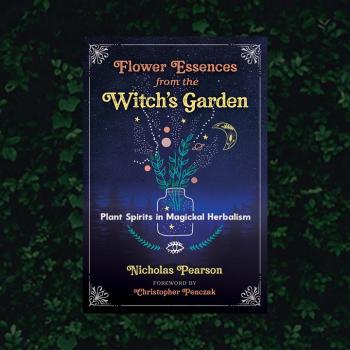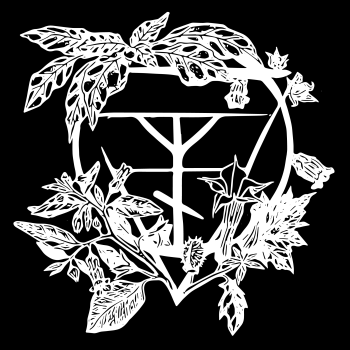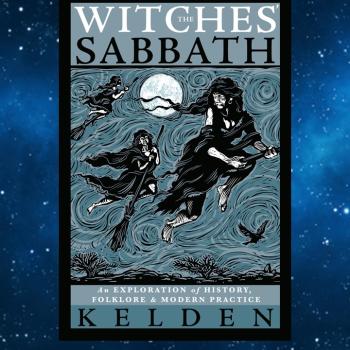Since I was a young child, I have had a fascination with plants. I loved working in the garden with my grandfather, helping plant seeds and pull weeds. The majority of my basic gardening skills I learned from watching and helping him. Of course the plants that I found the most fascinating were the exotic carnivorous plants that look like they are from another planet. I even had my own Venus Flytraps as a kid. At recess instead of playing sports I could often be found gathering strange flowers, and ball-shaped fungi with spores that puffed out in clouds of smoke. Another quirky hobby that I had throughout childhood was “potion-making,” which my grandmother patiently allowed as I made a mess of her kitchen. Taking ingredients from the cupboards and who knows where else, I would brew my concoctions with fascination. I definitely believe these were early signs of my fascination with the magic of the natural world and its occult secrets.
In my early teens I branched out from the fictional fantasy novels that I immersed myself in, and began studying what I discovered to be real witchcraft. I also learned about something called Wicca. At the time most of my research was done online, and I read as much as I could. Once I could finally get my own books I began reading more, using the Internet as a secondary source to reference. Over the course of my studies I have become knowledgeable in a wide array of occult practices from various traditions. I had also come across many formulas that mentioned seemingly fantastic ingredients, like mandrake and wolfsbane. Although, I had always had an interest in poisons, and appreciated the beauty of these deadly plants; I overlooked them initially because of their poisonous nature and difficulty in obtaining them. Initially formula’s that included these folk names seemed to fictional for me at the time.
Further study has introduced me to a large body of lore surrounding these “baneful herbs” from many historical accounts. Writings on the usage of various poisonous plants in different cultures across Europe, and archaeological findings have shown an extensive history of use over hundreds of years. Examples of their uses in in medicine for numerous purposes and large bodies of folklore show the important role these plants played in pre- modern society.
When I first began my studies fifteen years ago I had a very broad scope of information that I was faced with. As I became more verse in metaphysical concepts, and various magical traditions I was more discerning and able to find what made the most sense to me. There was also not nearly as much information online as there is today on occult practices let alone one as obscure as the ars veneficium.
Years ago beginning witches were faced with numerous independently published websites. Now there are more reputable communities, groups, and forums to choose from.
Many of the mainstream New Age books and Witchcraft 101 books give little explanation for this important practice. When the practice is mentioned little information is given other than to discourage their use and warn against contact. There are some recent publishers that have released books by authors like Daniel Schulke and Dale Pendell, who are well known authorities on the subject.
Their works are invaluable and contain some of the most useful information for the practitioner.
So what is the Poison Path exactly? Where does it lead, and what does it all entail? I suppose, like anything else, the answers vary depending on whom you are asking. There is a lot of misinformation and scare tactics out there that steer people away from this area of study. Although, they may have good intentions, they are missing out on a major part of the sorcerous experience. Some of the earliest words relating to the practice of witchcraft come from the Greek word Pharmakos and the Latin word Veneficium, and are directly related to the use of poisonous plants. In antiquity, the reality of magical practice is evidenced in laws relating to the prohibition of harmful magic. There was a clear and specific distinction between harmful magic and helpful magic. When we look at the pantheons of antiquity we see deities for every facet of human existence. Lay people as well as priest/esses made offerings and prayed to a variety of gods and goddesses.
When we look at the deities that are specifically associated with the practice of witchcraft there arises a common theme. The entities, and their correspondences, as well as sphere of influence; when speaking of witch gods can be categorized in a manner in which they share common themes. Many of these deities are associated with death, the underworld, and/or the ancestors. In the rituals of these spirits, the use of Saturnian botanicals is commonplace. Another sphere of influence is the wildwood; the ancient forests that were home to many of these “baneful allies.”
Most of the books written for beginners, if they mention this topic, will offer little information. Generally beginners are taught to avoid these plants completely, often by people who have them selves avoided working with them. I personally believe that doing so keeps one from making potentially beneficial connections. Magic is based on laws of correspondence; the macrocosm and microcosm, no plants better embody the quintessential nature witchcraft than the poisonous plants of the witch’s garden.
To walk the crooked path of the poisoner is to know how to harm as well as heal as traditional magical practitioners were commonly known to “work with both hands.” The path of the poisoner is a path of spiritual growth through communication with the verdant genii of the land. Through various rituals and incantations, a connection is made with this spirit at a primal level. It is through communion with this gate-keeping spirit that the secrets of the plant kingdom may be unlocked.
Each individual plant has its own animating spirit. There is also an overarching daimon of the entire genus. This is the genus’ collective consciousness, which encompasses all plants within the genetic family. Both entities are one and the same and distinctly separate. The most effective way to make contact with these spirits is to encounter the plant in its natural environment, regularly leaving offerings and meditating nearby. Another effective method for building this connection is growing the plants your self. Doing so facilitates an intimate connection and understanding of all stages of the plant’s life cycle.
Over the years I have come to realize that different practitioners have different affinities with specific spirit helpers or familiar spirits. It seems as though some people attract animal spirits, others feel more of a connection with plant spirits. There are likely many other categories that humanoid spirit familiars can fall into, but for these purposes I am focusing only on plant spirits. In fifteen years I have not been visited by, or felt a need for, any kind of animal spirit. I have two dogs, and there are a handful of animals that I share characteristics with. I also feel the power in the typical witch’s familiars: toad, bat, snake, wolf etc. I have always felt more connected to the green spirits of the forest and its denizens.
In addition to forming these spiritual relationships for guidance and knowledge, there are many practical applications for the plants themselves. For example, many of the herbs considered to be part of the witch’s pharmacopoeia are also sacred to the deities related to the occult and chthonic worlds. There are multiple mythological associations of poisonous plants and figures such as Hekate, Medea, and Circe. Because of these associations, the plants held sacred to these deities an others may be used as offerings and also in evocation.
There are other practical applications for these plants in addition to their many medical applications. Many of these plants are used in divination, communication with the dead, and summoning spirits.
The most common of these plants that are used in magical operations belong to the Solanaceae category; including mandrake, belladonna, nightshades, and henbane. All of these previously listed plants are infamous for their use in sorcery and magic. They have been used in love potions, philtres to see shades of the dead, and as general magical catalysts. The application that makes these plants so controversial is their use as tools for inducing trance states.
There is documentation of these plants being used historically in unguents and other preparations. There are also accounts of the hallucinogenic effects these entheogens had. However, the lack of modern information has led to much confusion about these plants and how they should be used. There are two ways that this information is typically presented, if it isn’t skipped over entirely. There are those that discourage any and all contact with these plants. They suggest harmless and ineffective substitutions. Then there are those who go into detail in regards to historical examples of intentional and accidental ingestion.
Few and far between are writers who are able to offer any firsthand information that is applicable to modern practice. This makes it nearly impossible for new practitioners to find useful information. Oftentimes doing your own research across multiple fields of study will yield more results.
Using these botanicals in the correct way can seriously enhance one’s magical practice. The sacred plants are magical catalysts used to empower tools and other formulas. Often used in incense fumigations, anointing infusions and topical unguents. Rarely are these botanicals ingested orally in modern practice, and it is difficult to determine a safe dosage for each person. Being a modern practitioner of traditional reconstructions; I believe it is important to maintain genuine practices and to maintain accurate records for future generations. Thanks to legal documents, trial records and archaeological findings, we have learned that these entheogens have been used by many cultures to achieve spiritual goals. It seems that the use of these botanicals in pre-Christian cultures and shamanic practices remains one of the best examples of a traditional practice still in existence today.
If you are interested in learning more about these plants, and how the are used it is important to gather information not only from reputable practitioners, but also from mainstream scientific/medical resources. It is detrimental that a theoretical understanding of these plants be developed through research. Also, growing the plants you want to work with gives one an intimate understanding of the plant’s nature. Using plant matter in charms and/or philtres is another way of facilitating a bond. The plant material should not be ingested in anyway until sufficient research is conducted. Using common sense and extra caution is imperative when beginning to work with these plants. As long as they are treated with respect they will make powerful allies.
-Coby Michael
















